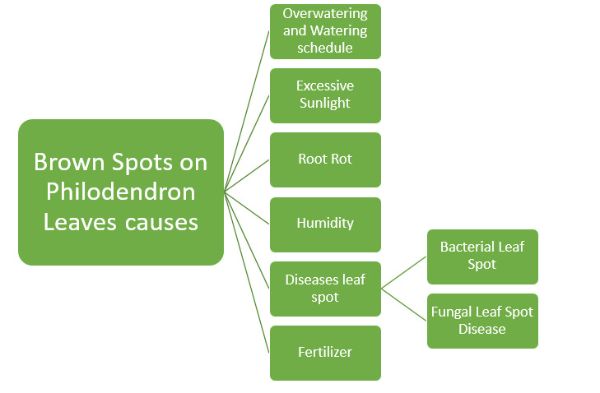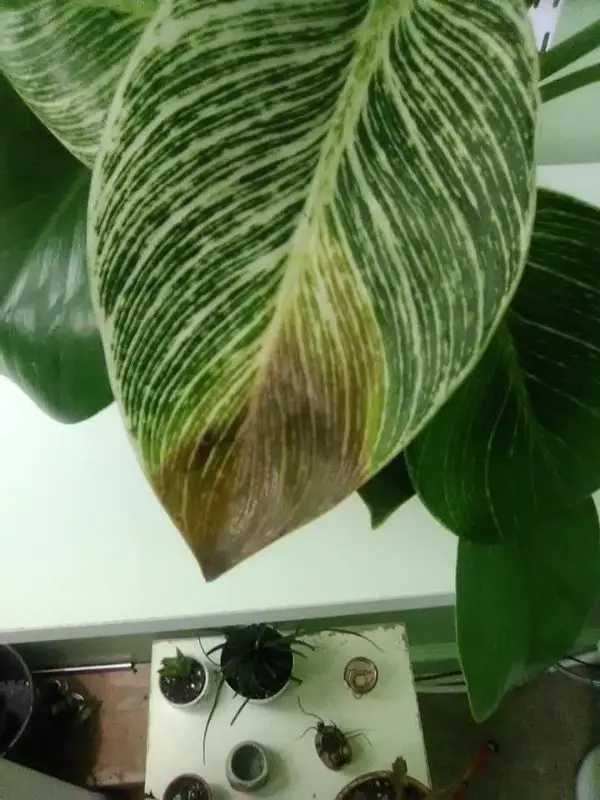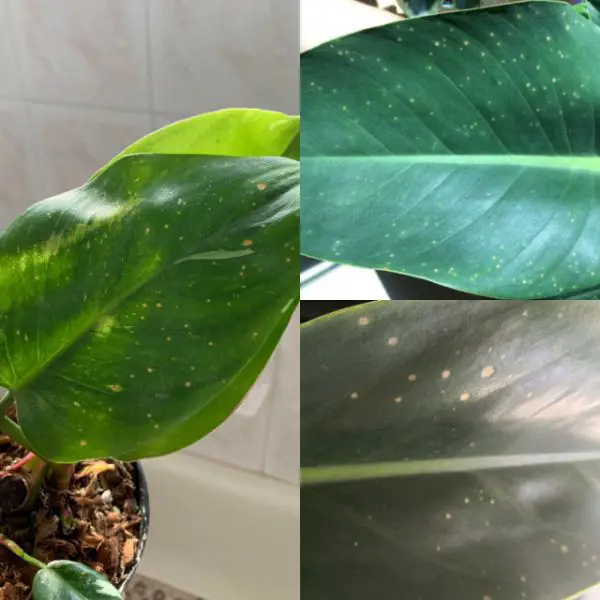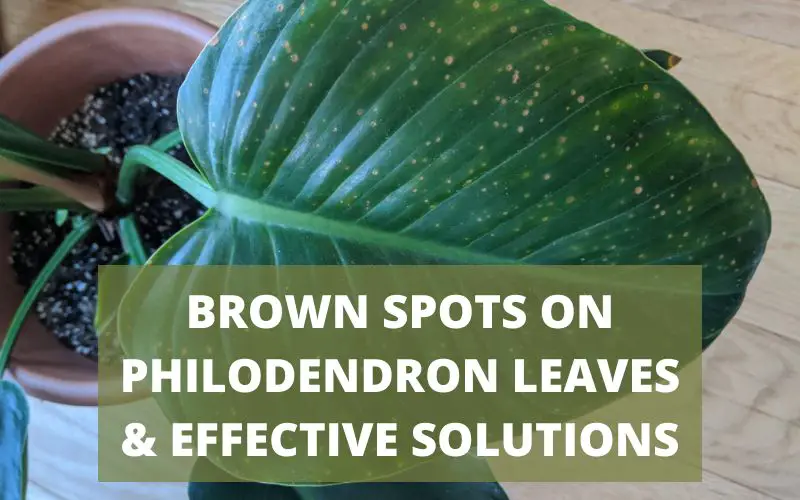If you’re like most Philodendron owners, you may have noticed brown spots on the leaves that you have assumed were just sunburn. Nope. They spread and spread to a healthy plant next to it. It can something that can kill your plant very rapidly if you don’t recognize it and if you don’t act upon it fast.
However, don’t worry – you’re not alone. This is a common problem for Philodendrons and there are several effective solutions. In this blog post, we will discuss what causes brown spots on Philodendron leaves and how to fix them. We’ll also provide some effective tips on how to prevent this problem from occurring in the future.
Does the presence of brown spots on Philodendron leaves indicate a dying plant?
In most cases, brown spots on Philodendron leaves are caused by a fungal disease called brown leaf spot. This disease is characterized by small, brown lesions that appear on the leaves. The spots may be surrounded by a yellow halo and can eventually lead to the death of the affected leaves.
Brown leaf spot is most often caused by waterlogged soil, so it’s important to make sure that your Philodendron is not overwatered. If you notice brown spots on the leaves of your plant, be sure to act quickly and remove any affected leaves. You can also try treating the plant with a fungicide.
If a brown leaf spot is left untreated, it can quickly kill a Philodendron plant. However, by taking some preventative measures and being vigilant about treating brown spots as soon as they appear, you can keep your plant healthy and disease-free
Let me explain the causes and solutions of brown spots on Philodendrons.
Brown spots on Philodendron leaves (causes and treatment)

Overwatering and Watering schedule
One of the main reasons brown spots show up on Philodendron leaves is due to overwatering. It’s very important to make sure your Philodendron isn’t getting too much water. Allow the top inch of soil to dry out between watering, and make sure that the pot has drainage holes to allow excess water to escape.
In order to test the topsoil, you need to stick your finger into it and hold it there for at least an inch. If your finger doesn’t have any soil stuck to it, it’s time to water.
If a Philodendron is neglected or dried out, the leaf will typically droop. Similarly, it is obvious that too much water has been applied when the leaves start to show brown areas in addition to droopiness.
Avoid using tap water to water your Philodendron instead; only use pure or distilled water.
For Philodendrons to thrive, water quality is also essential. Sodium and chlorine are present at high concentrations in ordinary tap water. Brown spots may emerge on the leaf as a result of salt building up in the potting soil.
Especially, don’t forget your philodendron watering schedule.
Solutions:
- Avoid using a hose or spraying tap water on your plants to water them.
- Instead, you can put your plant pot in a bathtub that is full of water. The plants’ roots soak up water this way and only absorb the necessary amount of water.
- Choose a soil mixture for your plant that provides the best drainage.
- Depending on how big the plant is and how much light it gets, you should be watering Philodendron plants every one to two weeks.
- Give Philodendrons a soak once a week while they are growing in the Spring and Summer.
- Similarly, water Philodendrons about every 10 days during the winter.
- You should let the top inch of soil dry out between waterings, and the soil should be damp but not soggy. If your plant is left submerged in water for a long time, the leaves will begin to show brown blotches.
Philodendron brown spots on leaves due to excessive Sunlight

Brown spots may also be a sign of too much sunlight. If your plant is in direct sunlight for more than six hours per day, it could be causing brown spots on the leaves. Try moving the plant to a spot with indirect light, and see if the brown spots disappear.
Solutions:
- Put your Philodendron close to a window that faces east. This is a perfect location because, although the sun may briefly shine on the leaves, it won’t do so for very long. Additionally, the intensity will be significantly lower than in a window with a west or south orientation, which may cause brown blotches on the leaves.
- You can shield your plant from the sun by using a physical barrier like an umbrella or a curtain.
- Philodendrons can thrive in low-light situations, therefore you may even use artificial lighting for them.
- Small, light-colored spots typically go away on their own within a few weeks if they are not too large. However, large or black patches may not go away and instead become permanent.
- You can try to get rid of the spots in this situation by gently clipping off the affected leaves using a pair of sharp scissors or a knife.
Philodendron brown spots on leaves due to root Rot
It’s time to look at the root of your Philodendron and continue to produce leaves with brown patches despite receiving adequate light and water.
Sometimes the root ball may be extremely damp even though the topsoil appears to be completely dry.
A healthy philodendron should always have white, sparkling roots.
The roots of the philodendron love to be a little crowded, and the plant also produces aerial roots.
However, brown, mushy roots are the main cause of the increasing number of brown spots on the leaves and indicate possible root rot.
The drainage holes in the pot are something to keep in mind. You don’t want your plant to languish in a pool of water, so make sure the pot has enough drainage holes.
The drainage holes frequently become clogged with soil, which makes it difficult for water to drain.
Solutions:
Although Philodendrons are resilient plant species. , it can be challenging to rescue a plant with root rot.
- It is crucial to remove the old, soggy soil and the rotten root system in order to resuscitate the plant.
- It’s equally crucial to remove the leaves with brown patches to stop additional harm.
- Then some new, moistened potting soil is all that is required for this Philodendron. It ought to wake up and sprout new growth in a few weeks.
- You can also take the plant out of the pot and look at the drainage holes to prevent root rot.
- In fact, you must examine the plant’s roots, soil, and pot at least once a year.
Philodendron leaves turning brown due to humidity
Low humidity can also cause brown spots on Philodendron leaves. If the air is too dry, the leaves may start to brown and crisp.
The cell walls of the leaves can be damaged by dry air, which can also cause the leaves to lose moisture, which can cause dehydration and browning.
Additionally, the leaves may have a harder time absorbing moisture from the surroundings if dust builds up on them.
Brown spots may result from fungus growth, which is more likely to occur under low humidity.
One of the main environmental conditions that contribute to brown stains on philodendron leaves is low humidity.
Solutions:
- You should mist the leaves with filtered or distilled water One of the simplest ways to increase the humidity in the plant’s surrounds
- The leaves get enough moisture from a daily misting. Additionally, misting will prevent the leaves’ tips and patches from becoming brown. However, be careful that your Philodendron does not remain persistently damp since this will serve as a breeding ground for pests.
- A humidifier is another excellent and simple way to raise humidity levels for the benefit of plants
- Plants should ideally be placed in areas with greater humidity levels, such as the laundry room, kitchen, and bathroom.
- In a pebble tray, arrange the plants.
- To boost humidity, try spraying the plant’s leaves with water or setting it in a pebble tray.

Brown spots on Philodendron leaves due to Pests
Pests, aphids, mealybugs, and spider mites can all cause brown spots on leaves.
Examine your plant attentively and check for tiny insects if you think pests are to blame.
Aphids produce a sticky material that collects debris and dirt and makes in brown blotches on the leaves. Similar to this, spider mites leave little, light-colored dots on Philodendron leaves as evidence of their feeding. The leaves eventually turn brown, dry out, and drop off.
Because spider mites attack plant cells, they can inflict more harm. And as a result, the leaves may develop brown spots that might spread outward until the entire leaf curls up and turns brown.
Examine your plant attentively and check for tiny insects if you think pests are to blame.
Solutions:
- Cut off bad leaves with my right hand, highly affected portions of the plant avoid healthy leaves, and treat soil with peroxide and water.
- Dust mites should not develop at all with regular misting and cleaning of individual leaves on both sides.
- Then use tea tree oil, baking soda, neem, or vegetable oil mixed with water and spray each stem and leaf top and bottom
- Treating the plant with a pesticide should get rid of the problem of brown spots on Philodendron leaf stems so it won’t spread.
- You may treat with a Fungicide spray plant.
- When using spray-on remedies, cover the undersides of the leaves as well and keep going until the infestation is gone.
- You may produce a solution for spider mites by mixing three parts of water with one part of dishwashing liquid. It should deter them if you apply it to the leaves and then wipe it off
Diseases leaf spot
It’s important to look into the diseases of Philodendrons if the leaves wilt quickly, frequently turn yellow, or have brown blotches on new growth.
The two ailments that Philodendrons are most prone to are listed below:
Bacterial Leaf Spot
Bacterial leaf spot is a common problem for Philodendron plants. The bacteria that cause this disease thrive in warm, wet conditions.
Transparent regions on the leaf edges turn brown with tan or yellow haloes due to the infection that produces bacterial leaf spots.
Similarly, if you overwater for your Philodendron, bacteria may flourish in the soil because they prefer moist surroundings.
The spots randomly appear on leaf surfaces and have irregular shapes, and non-uniform patterns.
Solutions:
- It is necessary to remove any diseased plant matter.
- Apply copper soap to the damaged plant parts after removal to stop the spread.
- Avoid low temperatures, crowded plants, and water splashing or sprinkling on the foliage.
- Clean up any leftover vegetables from the garden, and stay away from growing new crops where host plants once grew well.
- Avoid watering from above. It is best to refrain from overhead irrigation. It will prevent moisture from condensing on the leaves of your Philodendron.
Note: Plants with Bacterial Leaf Spots cannot be treated chemically
Fungal Leaf Spot Disease
The illness appears to be more common during humid, hot summers. Wind, rain, or polluted soil can bring the pathogens that cause it into touch with the leaves.
Disease symptoms
The diseased young leaves are where the disease first shows its symptoms. The lesions feature a protrusion in the middle and yellowish-green margins before turning brown.
On the leaf surface, brown dots appear, spread, and cover the majority of the leaf.
The most typical sign of a leaf spot infection is spotted on the leaves. They are brownish and can also black or be tan.
Solutions:
- To cure bacterial leaf spots, use fungicides.
- Use fungicides like Daconil, Benlate, Mertect,Dithane, Captan, and Dithane
- Keep the temperature at least 70°F (21°C)
- Put your Philodendron container apart from other gardens.
- Some fungi illnesses can be avoided by getting rid of weeds and decaying leaves.
- Trim away the diseased leaves.
- Any plant gets bacteria and fungus through wounds
- Spread out your pruning over a period of time rather than doing it all at once.
- Please stop misting your plant.
- Some fungi illnesses can be avoided by getting rid of weeds and decaying leaves.
Fertilizer
Fertilizer is necessary for Philodendron plants to flourish. However, excessive fertilization might also cause brown spots on leaves. Additionally, it might lead to can harm the plant’s roots and have adverse effects on the plant
On the other side, a calcium and magnesium deficit results in yellow patches on leaves that eventually turn brown.
Your Philodendrons’ leaves will develop brown leaf tips and margins as a result of overfertilization.
Similar to that, it also results in the lower leaves withering. Therefore, refrain from using too much, too often, or at a concentration that is too high.
During the growing season, you can use a balanced water-soluble fertilizer once a month, diluted to half strength. Avoid feeding inside in the fall and winter.
Solutions:
- During the growing season, you can use a balanced water-soluble fertilizer once a month, diluted to half strength.
- Avoid feeding inside in the fall and winter.
- Pruning is necessary for scorched and browned leaves.
- Slow-release pellet fertilizers can take the place of liquid fertilizers.
- After that, scoop out the top one or two inches of soil and refill it with fresh soil.
- Remove any fertilizer that is readily visible from the soil and plant, and let water flow through the roots to wash the fertilizer away.
- From spring through summer, Philodendrons need to be fertilized once a month. In the fall and winter, fertilize once every six to eight weeks.
- Utilize chemical fertilizers like balanced liquid foliage booster, all-purpose liquid fertilizer, or NPK
- Repot your Philodendron if it still doesn’t appear to be recovering.
- Additionally, don’t fertilize the plant until it has fully healed and looks healthy.
- To flush the soil using water, run water to the soil for 6–10 minutes. You can use a low flow on the garden hose and move it to distribute the water on the soil.
- By doing this, water will be able to transport away the salts and extra minerals that have accumulated in the soil as it drips down the side of the pot. Before placing the pot back in its original location after six to ten minutes, let the dirt completely drain.
Tips to Prevent Brown Spots
Brown spots on Philodendron leaves can be unsightly and may even lead to leaf drops. Fortunately, there are a few things you can do to prevent this problem.
One of the most important is to make sure that the plant has enough light. Brown spots are often caused by insufficient light, so make sure to give your Philodendron a bright spot in your home or office.
Pruning and removing any dead, dying leaves, or beginning to turn brown.
Another important step is to water the plant regularly, but not too much. Overwatering can also cause brown spots, so be sure to let the soil dry out somewhat between watering.
Philodendrons require humidity, so spray the foliage frequently or place the plant on a pebble tray. Give your philodendrons some water early thing in the morning so they can refill themselves.
Refrain from watering your Philodendron from above. You might alternatively pour the water onto a saucer and let the plant take it from underneath. Rainwater or distilled water are preferred for philodendron. But if you use tap water, be careful to leave the lid off and let it sit for at least a day.
Always spray leaves before wiping them with a cloth or a paper towel. The leaves will benefit from the humidity, and cleaning them thoroughly will get rid of the dust, preventing the growth of dust mites.
Rotate your pot once a month for continuous development. Turning the plant guarantees that it grows from all directions as a result
Finally, be sure to fertilize your philodendron on a regular basis.
To avoid giving the plants brown blotches, dilute liquid fertilizer with water before applying it. Use a potting mix that drains well. During the growing season, fertilize your philodendron once a month
By using these suggestions, you can avoid brown spots on Philodendron leaves and maintain the health and happiness of your plant.
Conclusions
While the presence of brown spots on Philodendron leaves may be alarming, it does not always mean that a plant is dying. There are many causes for these spots and with proper treatment, most plants will recover. It is important to correctly identify the cause of the brown spots before taking any corrective action. With a few tips from DIG Nursery, your plants can be healthy and thriving again in no time! Has your plant developed brown spots? What did you do to treat them?



